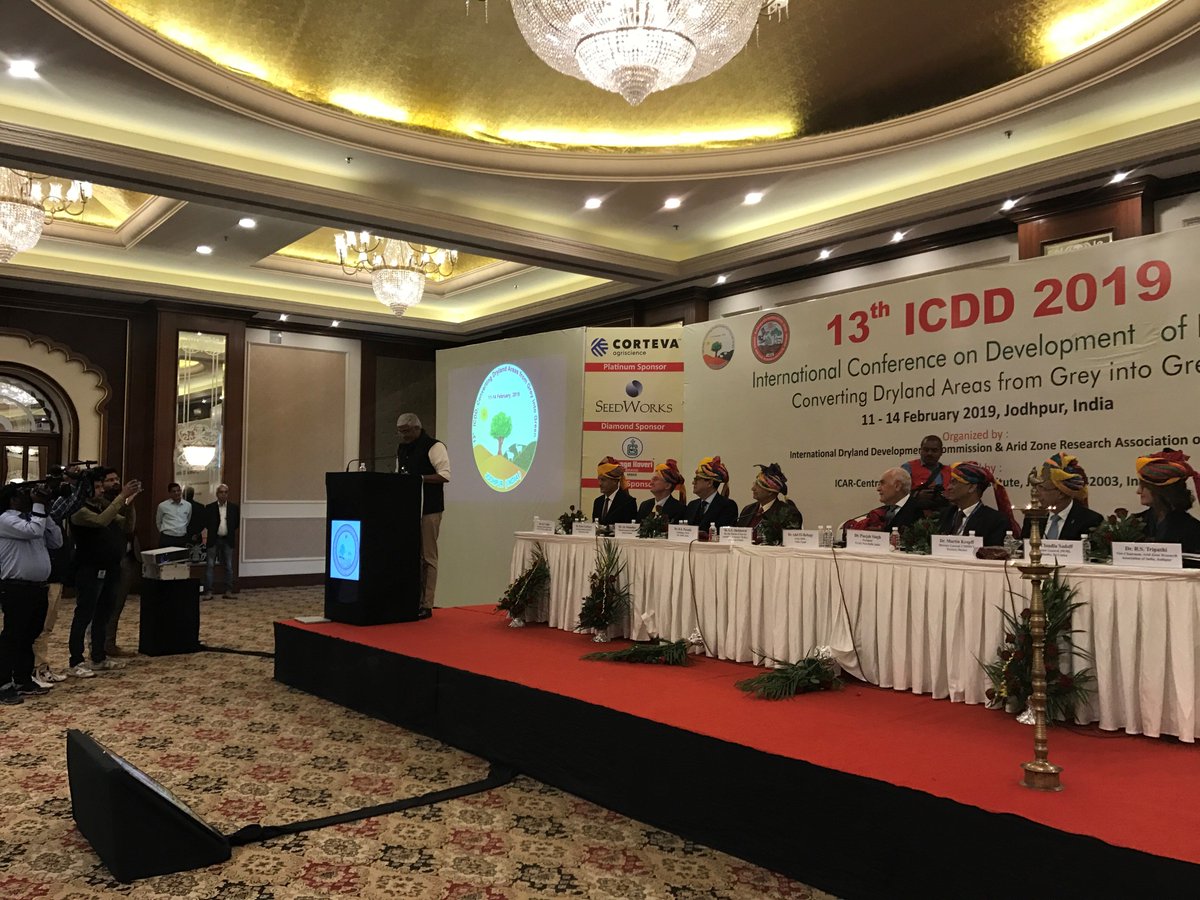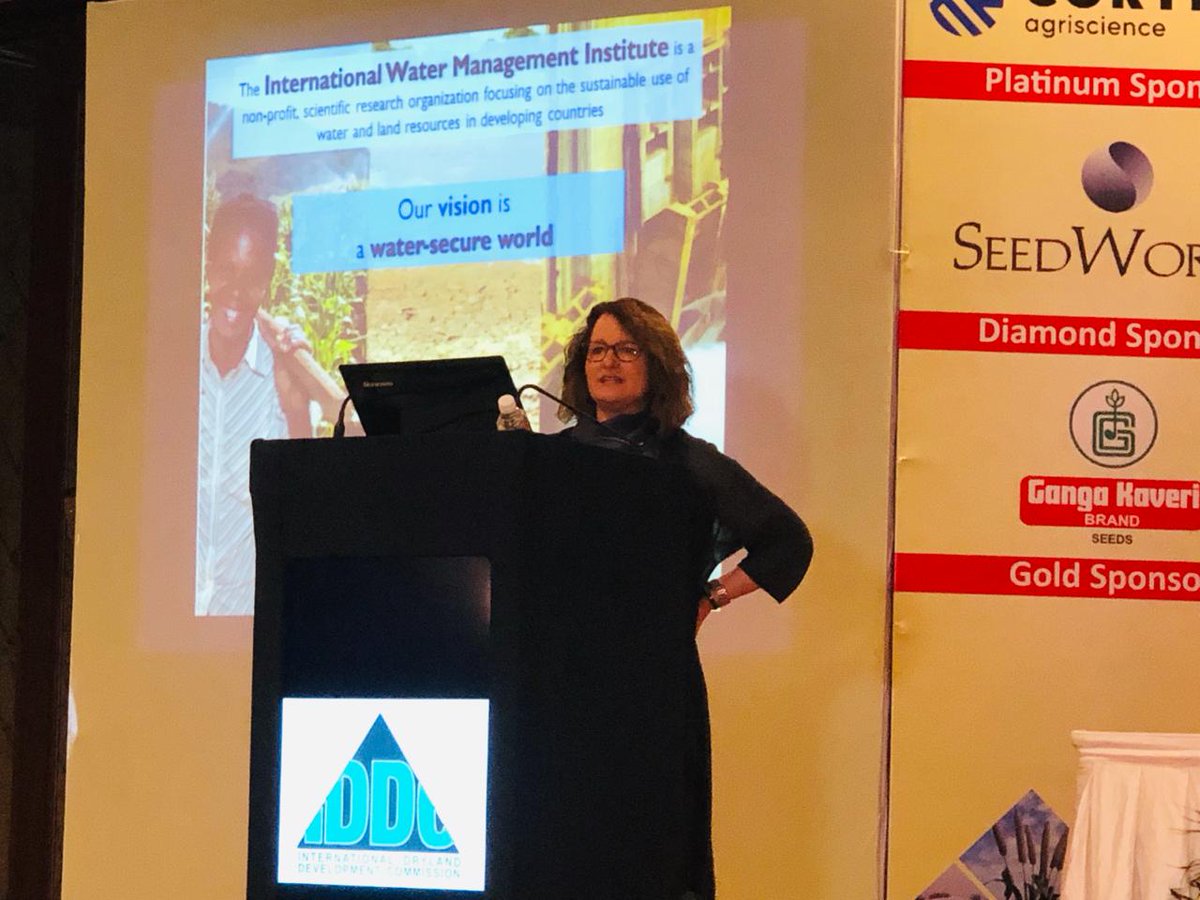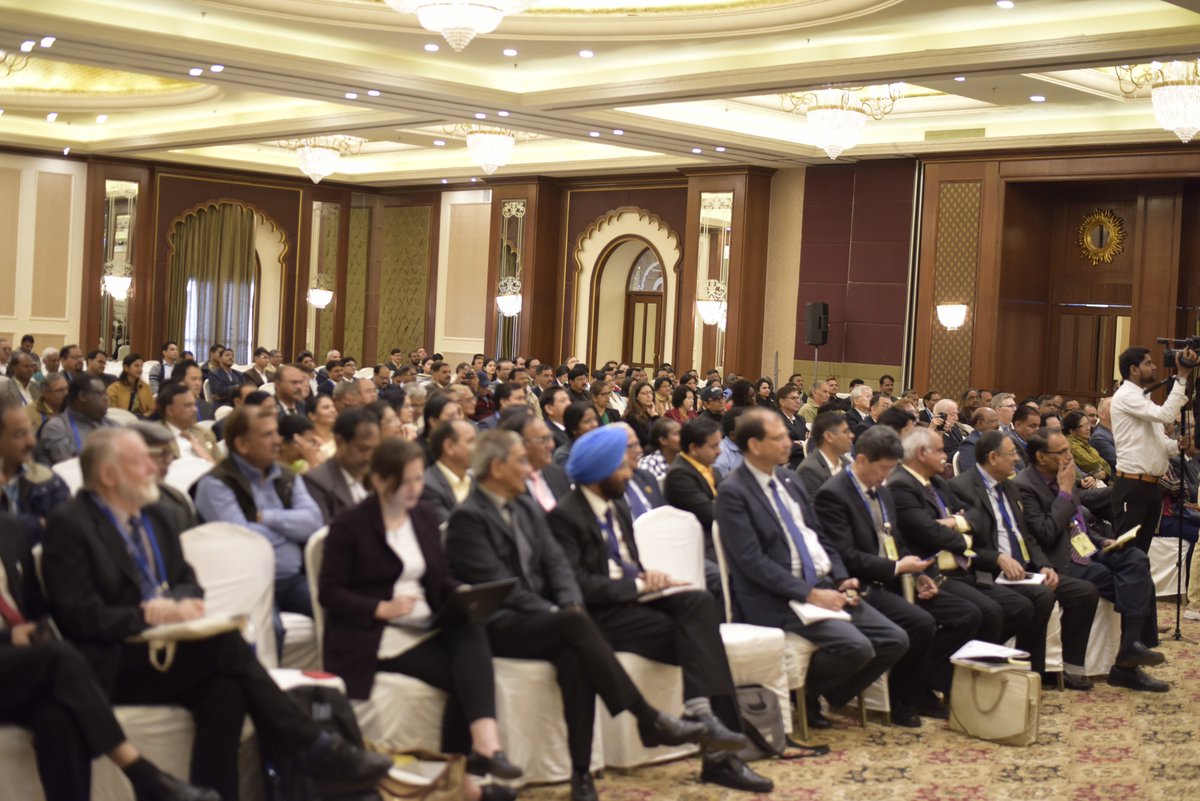 11-14 February 2019. Jodhpur, India. The 13th International Conference on Dryland Development, with the theme "Converting Dryland Areas from Grey into Green", is organized by IDDC (International Dryland Development Commission) and the Arid Zone Research Association of India (AZRAI) and hosted by the ICAR-Central Arid Zone Research Institute (CAZRI).
11-14 February 2019. Jodhpur, India. The 13th International Conference on Dryland Development, with the theme "Converting Dryland Areas from Grey into Green", is organized by IDDC (International Dryland Development Commission) and the Arid Zone Research Association of India (AZRAI) and hosted by the ICAR-Central Arid Zone Research Institute (CAZRI).
 |
| Gajendra Singh Shekhawat (Indian Minister of State for Agriculture and Farmers Welfare) addressed the Inaugural Session |
 The efforts of the research and development community and of policymakers dealing with dry areas and aiming at sustainable management of natural resources have to be boosted in order to optimize adaptive mechanism and risk aversion elements for the dryland communities.
The efforts of the research and development community and of policymakers dealing with dry areas and aiming at sustainable management of natural resources have to be boosted in order to optimize adaptive mechanism and risk aversion elements for the dryland communities. ICARDA contributed to this conference with not least than 8 presentations (see further)
ICARDA contributed to this conference with not least than 8 presentations (see further)- Innovations built on traditional knowledge and modern technology for sustainable dryland agriculture 605 views
- Field crops breeding for resistance to biotic and abiotic stresses at ICARDA: Achievements and prospects. 248 views
- Pulses for Harvesting ‘More from Less’ in Dry Areas 465 views
- Durum wheat ideotype for the drylands of tomorrow 341 views
- Big Data and Digital Augmentation for Accelerating Agroecological Intensification 412 views
- Improving Agricultural Water Productivity in the Indira Gandhi Nahar Pariyojana (IGNP) 515 views
- How to set priorities and capture market/farmers' needs 211 views
- Conservation and use of agrobiodiversity in CWANA drylands, 181 views
Themes of technical sessions of the conference:
- Technical Session 1: Impact of Climate Change in Drylands (Theme 1)
- Technical Session 2: Managing Land Degradation & Desertification (Theme 2)
- Technical Session 3: Soil Health Management, Carbon Sequestration and Conservation Agriculture (Theme 3)
- Technical Session 4: Conservation & Use of Agrobiodiversity; Developing Adapted Cultivars (Theme 5)
- Technical Session 5: Water Harvesting & Improving Water Productivity
- (Theme 4)
- Technical Session 6: Conservation & Use of Agrobiodiversity, Developing Adapted Cultivars (Theme 5)
- Technical Session 7: Sustainable Intensification & Diversification (Arid Horticulture, Aquaculture, Protected Agriculture) (Theme 6)
- Technical Session 8: Livestock, Rangeland and Agroforestry Management (Theme 7)
- Technical Session 9: Conservation & Use of Agrobiodiversity, Developing Adapted Cultivars (Theme 5)
- Technical Session 10: Post Harvest Management, Value Chain, Renewable Energy, Farm Mechanization and Automation (Theme 8)
- Technical Session 11: Policies, Institutions & Markets to Improved Livelihood Security (Theme 9)
 Themes of the Satellite symposium
Themes of the Satellite symposium- Crop Improvement for Sustainable Production
- Big Data in Dryland Agriculture
- Mainstreaming Water Productivity in Drylands
- Dryland Agrobiodiversity for Adaptation to Climate Change
- Arid Agro-ecosystem: Challenges and Opportunities
11 February 2019
Guests of honor:
- Dr. Peter Carberry, (see picture) Director General ICRISAT, Patancheru, India
Risk mitigation in dryland agriculture: Prospects and realities - Dr. Martin Kropff, (see picture) Director General, CIMMYT, Texcoco, Mexico
Maize and wheat science for alleviating the pressure on natural resources in drylands - Prof. Dr. Adel El-Beltagy, (see picture) Chair International Dryland Development Commission
Navigating through uncertainties: Agro-ecosystems affected by dynamic impact of climate change - Dr. Claudia Sadoff, (see picture) Director General, IWMI, Colombo, Sri Lanka
- Dr. Raj S. Paroda, Chairman of the Trust for Advancement of Agricultural Sciences (TAAS) New Delhi, India
- Dr. Panjab Singh, President, National Academy of Agricultural Sciences (NAAS), New Delhi, India
- Prof. T. Mohapatra, Director General of the Indian Council of Agricultural Research (ICAR) and Secretary Department of Agriculture Research and Education (DARA), Ministry of Agriculture, Government of India
- Mr. Aly Abousabaa, Director General ICARDA, Beirut, Lebanon
Role of traditional knowledge combined with new innovative technologies in achieving (see presentation below)


 |
| Mr. Aly Abousabaa, Director General of ICARDA on how synergy between traditional knowledge and innovation would contribute to livelihood in dry areas |
"Evidence shows that the dry areas and the MENA region specifically, for example, is heading towards a much warmer climate scenario over the next 50 years than initially anticipated."
"As highlighted by the IPCC Special report on impacts of global warming in October 2018, climate change impact can be avoided by limiting global warming to 1.5 degrees Celsius compared to 2 degrees, or more. Also noted in this report
is that by limiting global warming, people and ecosystems will have more room to adapt and remain below relevant risk thresholds. To undertake this critical adaptation, appropriate local intervention schemes can be applied and instead interrupt negative effects of climate change."
"Published last month, the EAT-Lancet report on Food in the Anthropocene cites the need for environmental systems and processes to be maintained for sustainable food production. Global food systems transformation is needed urgently to ensure long-term sustainability both in terms of food production and to reduce the threat to local ecosystems. Mr. Aly Abousabaa (see picture), Director General of ICARDA"
12 February 2019
12 February: Technical Session 4: Conservation and Use of Agrobiodiversity; Developing Adapted Cultivars (Theme 5)- Field crops breeding for resistance to biotic and abiotic stresses at ICARDA: Achievements and prospects. Lead Lecture 1 - Dr. Michael Baum, Director BIGM, ICARDA, Beirut, Lebanon
 |
| Dr. Michael Baum, on behalf of Filippo, presenting durum wheat research carried out at ICARDA to make it climate smart crop @fillobax @ICARDA |
The marginal region is the place where one or more of the factors necessary for plant production do not reach the level of the requirement.
To achieve the goal to produce the necessary amount of crops under the changing climate, we need to extensively improve the crop varieties combining knowledge and technologies of molecular biology, genetics, physiology, informatics, modeling, and others. This satellite symposium is aimed to exchange the research activities among researchers studying cereals, pulses, and root symbiotic microbes, and know the present status and prospects to develop marginal regions for sustainable crop production.
- Water-saving wheat: tuning water use efficiency and drought tolerance using ABA receptors Dr. Ryosuke Mega
- Durum wheat ideotype for the drylands of tomorrow Dr. Filippo Bassi Senior scientist ICARDA (durum breeder) and Dr. Michael Baum (see picture) BIGM Program (Biodiversity and Integrated Gene Management ) and Morocco Platform Director ICARDA, RABAT
 |
@Michael31231609 from @ICARDA in his
closing presentation highlighted role of
for developing stress resistance crops |
- Manipulation of centromere specific histone H3 (CENH3) in crop plants for haploid breeding: towards sustainable food production in dryland Dr. Takayoshi Ishii
- Pulses for harvesting more from less in dry areas
Dr. Shiv Kumar Agrawal (see picture)
Shiv Kumar Agrawal leads ICARDA’s Food legumes program, which aims to deliver improved germplasm of lentil, kabuli chickpea, faba bean, and grass pea to national partners in South Asia, sub -Saharan Africa, West Asia, and North Africa.

- How to find effective root symbiotic microbes for crops? -Toward the use of customized microbes for sustainable agriculture in an object area Dr. Takeshi Taniguchi
- Barley improvement for marginal lands Dr. Ramesh Verma
- Discussion Crop improvement for the dry areas/ Conclusions and closing remarks Dr. Michael Baum
- Rapporteur: Dr. Vinay Nangia (see picture) Senior Hydrologist, ICARDA Specially Appointed Associate Professor IPDRE, Tottori University

Agricultural research is
becoming more and more data intensive. High-throughput genotyping, precise phenotyping, drones, imaging platforms, GIS/RS, socio-economic information, climatic
sensors, IoT and various kinds of data streams are pouring data to scientists to leverage their research to next level.
- Big Data and Informatics Platforms at ICRISAT and future strate- Dr. Abhishek Rathore
- The CGIAR platform for big data in agriculture: Towards big-data enabling agriculture development Dr. Brian King
- GOBii, a Scalable Genomics Data Management System with Rapid Data Extract Times and Integration with Downstream Genomic Selection Analysis Pipelines Dr. Elizabeth Jones
- Big Data and Digital Augmentation for Accelerating Agroecological Intensification
Dr. Chandrashekhar
Biradar (see picture)
Dr. Chandrashekhar Biradar is a Principal agroecosystems scientist and head of Geo-informatics Units, ICARDA. He is a distinguished scientist in the field of geo-informatics science and technology. He has multidisciplinary science background with focus on digital augmentation for accelerating agro-ecological intensification

- Seeing is Believing: Using Smartphone Pictures for Agricultural Risk Management Dr. Berber Kramer
- Big Data in Indian Agricultural Research and Development Dr. Rajendra Parsad
- Breeding Modernization at ICRISAT: Implementing Industry Principles in the Public Sector Dr. Jan Debaene
13 February 2019
 |
| Dr. Vinay Nangia Senior Hydrologist, ICARDA |
13 February: Technical Session 5: Water Harvesting and Improving Water Productivity
(Theme 4)- Improving Agricultural Water Productivity in the Indira Gandhi Nahar Pariyojana (IGNP) A joint project between ICARDA and CAZRI Vinay Nangia (see picture), N.D. Yadava, M.L. Soni and V.S. Rathore
 |
| Dr. Ashutosh Sarker talking at ICDD about how to intensify and diversify rice based systems with lentil and grass pea @ICARDA @alyabousabaa |
- Intensification and diversification of dryland production systems with winter pulses in South Asia Dr. Ashutosh Sarker, Coordinator, ICARDA’s Regional Program for South Asia and China, New Delhi, India
13 February: Satellite Symposium Mainstreaming Water Productivity in Drylands
Low precipitation and prolonged dry seasons in the drylands can lead to water scarcity, and limit agricultural productivity and output. Therefore, it is critical to achieve efficient inter-sectoral coordination to enable utilization of available water resources to the best advantage. The maximum potential for expansion of agricultural areas and benefits from improved water productivity lies in arid and semi-arid regions. This mini-symposium enabled exchanges among researchers working in the area of water management to share knowledge on the present status and prospects for higher water productivity in the drylands. The deliberations helped in framing a strategy for managing water for increasing water productivity and mainstreaming it in drylands at scale through appropriate institutional frameworks and policies.
13 February: Satellite Symposium Dryland Agrobiodiversity for Adaptation to Climate Change
Amongst the total 34 global hotspots, 9 are in the dry lands and about 0.5% of the plant species are endemic to the region. In terms of agriculture, plant species endemic to the drylands make up 30% of the plants under cultivation today, including many ancestors and crop wild relatives (CWRs). However, exact status of species in the dry lands remains unknown, as no comprehensive assessment has been collated. The objectives of this mini-symposium were:
14 February: Satellite Symposium Arid Agro-ecosystem: Challenges and Opportunities
The Arid ecosystem covers around 17% of the world's land area and are inhabited by about 6% population which manifests insurmountable challenges due to inhospitable climate, vast livestock and human population surviving on limited and fragile natural resources.Low precipitation and prolonged dry seasons in the drylands can lead to water scarcity, and limit agricultural productivity and output. Therefore, it is critical to achieve efficient inter-sectoral coordination to enable utilization of available water resources to the best advantage. The maximum potential for expansion of agricultural areas and benefits from improved water productivity lies in arid and semi-arid regions. This mini-symposium enabled exchanges among researchers working in the area of water management to share knowledge on the present status and prospects for higher water productivity in the drylands. The deliberations helped in framing a strategy for managing water for increasing water productivity and mainstreaming it in drylands at scale through appropriate institutional frameworks and policies.
 |
| Dr. Ahmed Amri speaking about science based approaches for efficient conservation and use of genetic resources at ICDD @ICARDA @alyabousabaa |
Amongst the total 34 global hotspots, 9 are in the dry lands and about 0.5% of the plant species are endemic to the region. In terms of agriculture, plant species endemic to the drylands make up 30% of the plants under cultivation today, including many ancestors and crop wild relatives (CWRs). However, exact status of species in the dry lands remains unknown, as no comprehensive assessment has been collated. The objectives of this mini-symposium were:
- To examine the current threats to dryland agrobiodiversity, deliberate upon the opportunities and challenges due to climate change, and the required policy interventions to overcome the threats and challenges.
- To take stock of agrobiodiversity in the Indian, Central and West Asian, and North African dryland regions and management strategies of their genetic resources.
- To Identify the possible role of regional and international organizations in management of dryland agro-ecosystems through research and development, in partnership mode forharnessing agrobiodiversity to address the global challenges being faced by dryland communities.
Presentations
- Conservation and use of agrobiodiversity in CWANA drylands, Ahmed Amri (see picture), ICARDA, Morocco Head of ICARDA's Genetic Resources Unit, which runs the GRU seed bank in Rabat.
- How to set priorities and capture market/farmers' needs Dr. Filippo Bassi Senior scientist ICARDA (durum breeder) and Dr. Michael Baum BIGM Program (Biodiversity and Integrated Gene Management ) and Morocco Platform Director ICARDA, RABAT
14 February 2019
Generation of technologies for conservation and efficient utilization of resources holds key for transforming less productive arid lands to gainful livelihood resources for farmers of these regions. Despite of several limitations, many opportunities exist in arid lands. The symposium will discuss some of the key issues concerning the conservation of natural resources, their optimum utilization and livelihood security. These include:
- Changes in Land use patterns and role of space technologies in food, energy and water security in arid regions
- Natural resource vulnerability under climate change and biological indicators of land degradation and agradation
- Livestock scenario in arid regions and their role in livelihood security
- Integrated farming system approach for arid ecosystem and opportunities in horticulture
- Chairs - Prof. Ramesh Chand, Member, Niti Aayog, Government of India, New Delhi
- Co-chairs - Prof. Dr. Adel El-Beltagy, Chair, International Dryland Development Commission, Former Minister of Agriculture and Land Reclamation, Cairo, Egypt
- Dr. Ashok Dalwai, CEO, National Rainfed Area Authority, Government of India, New Delhi
- Dr. Raj Paroda, Chairman, TAAS, New Delhi, India
- Dr. Panjab Singh, President, NAAS, New Delhi, India
- Sh. Pawan Kumar Goyal, Additional Chief Secretary - Agriculture, Rajasthan, India
- Dr. Aly Abousabaa, Director General, ICARDA, Beirut, Lebanon
- Ms. Maria Beatix Giraudo, Former President, AAPRESID, Senior Advisor to Govt. of Argentina
- Prof. Wang Tao, President, Lanzhou Branch of CAS, China
- Prof. Atsushi Tsunekawa, Professor, ALRC, Tottori University, Tottori, Japan
- Prof. Academician Guram Aleksidze, President, GAAS, Georgia
- Dr. S.K. Malhotra, Commissioner (Agriculture), Govt. of India, New Delhi, India
- Prof. Mohamed F. Osman, Former Chair, General Authority for Fish resources Development (GAFRD), Egypt





No comments:
Post a Comment